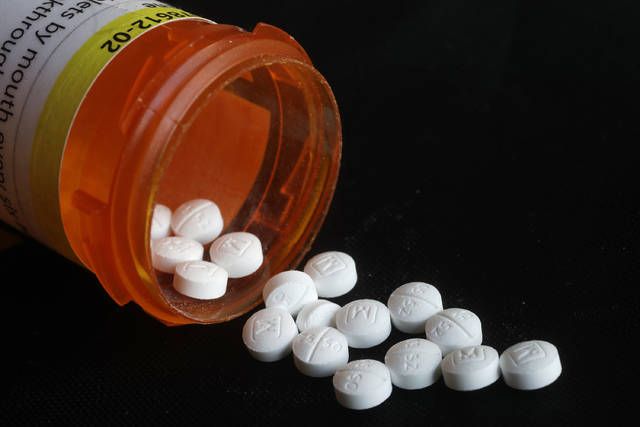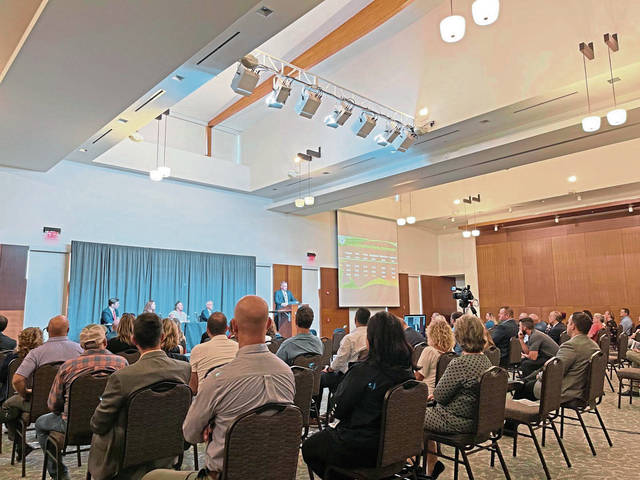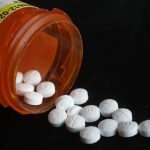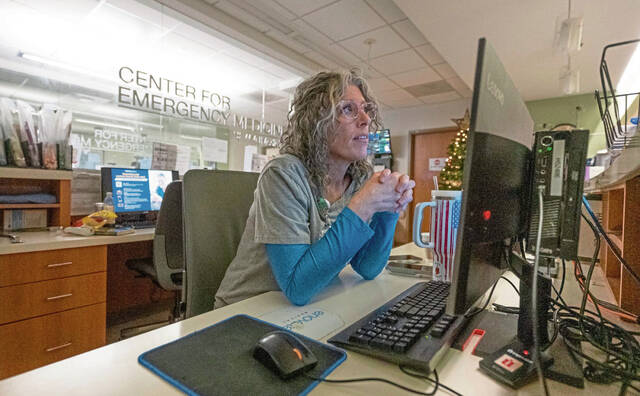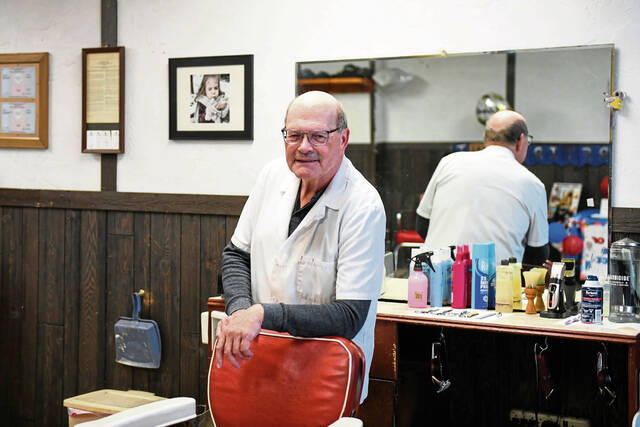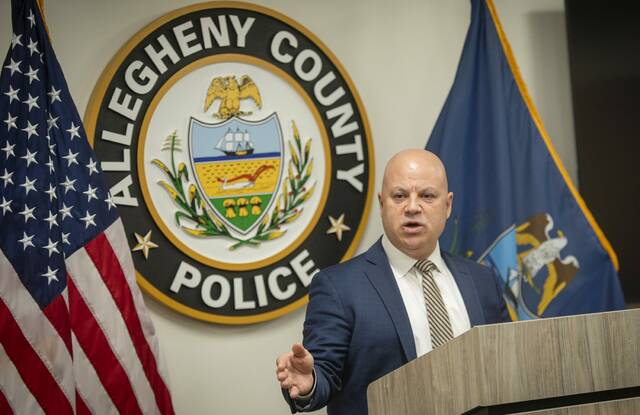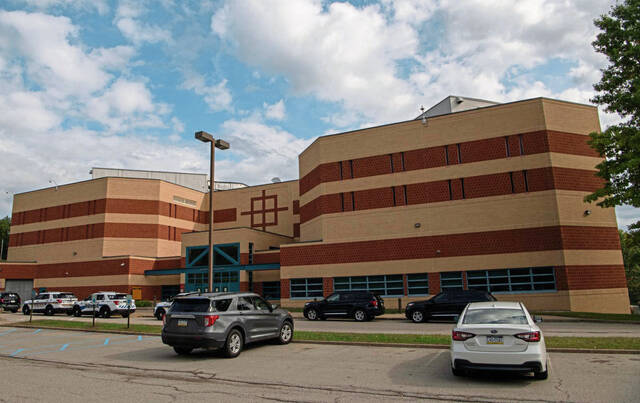Throughout the height of the covid-19 pandemic, it seemed as if the opioid epidemic had come to a sudden halt — largely because coronavirus headlines dominated newsstands, television broadcasts and everyday conversation.
The latest overdose death figures from the Centers for Disease Control and Prevention, however, convey a starkly opposite truth.
More than 93,000 people died of drug overdoses in 2020 — the highest number ever recorded and a staggering 30% jump from 2019 because of the prevalence of lethal fentanyl and pandemic-induced causes, according to the CDC.
“In today’s world, when you mess up, you’re dead,” said Rich Jones, a board member of Greensburg-based Sage’s Army, of the increased lethality of substances over time. “It’s almost beyond comprehension. How do you combat that when people can’t even have a slip? … That’s not how recovery works.”
Sage’s Army is a Recovery Community Organization that provides services to those with substance use disorders.
Before Ken Bacha became county coroner in 2001, his father served in the role for 24 years.
“You could count on one hand” the number of opioid deaths that occurred during that time period, Bacha said last week as a panelist at the 2021 Western Pennsylvania Drug Summit held at Saint Vincent College.
Opioid-related deaths peaked in Westmoreland County in 2017, reaching 193. The count decreased to 122 and 115, respectively, in 2018 and 2019. Last year, there were 123.
Overdose deaths in 2021 are on pace to reach 188 — or nearly on par with 2017’s record high, Bacha said. As of July 9, there were 65 confirmed drug and alcohol overdoses this year, with 29 pending toxicology and autopsy.
“I don’t really see what would stop that right now,” Jones said. “I don’t see how those trends don’t continue unless we do something drastic.”
In Allegheny County, overdose deaths also peaked in 2017 at 737. The 689 overdose deaths were second highest in a decade, after having fallen to 492 and 571, respectively, in 2018 and 2019.
Of the 689 fatal overdoses in 2020, 77% of the victims had fentanyl in their system.
Fatal fentanyl
The primary drivers of the 30% increase in overdose deaths nationwide are illicitly manufactured fentanyl, increased counterfeit prescription pain medication and methamphetamine, said Regina Labelle, acting director of the White House Office of National Drug Control Policy.
Labelle delivered a prerecorded message to the regional drug summit, held Wednesday at the Fred Rogers Center. When she spoke at the summit in 2012, she said drug overdose deaths nationwide were approximately 20,000, a number mainly driven by prescription opioids, not fentanyl.
“(We’re) not sure what 2021 will bring, but we do know that the drug supply continues to contain a lot of fentanyl,” Labelle said. “Synthetic opioids are present in almost all of the overdose deaths.”
Labelle said she and others working closely with the epidemic need to be “mindful” of new synthetic drugs that are emerging, and she said she believes covid-19 has “exacerbated” overdose rates.
“I think that it was predictable,” Jones said of the 2020 overdose numbers. “We really don’t have a good infrastructure in place to connect with people to begin with, and then when you take (in-person interaction) away, you’re really left with nothing.”
Carmen Capozzi, founder of Sage’s Army, said he believes not being able to connect with people throughout the pandemic wasn’t ideal, and isolation isn’t optimal for people who struggle with substance use disorders.
“I don’t think we’ve seen the whole impact of that yet,” Jones said. “(There will) still (be) a longer-term effect of stress and anxiety around the pandemic — depression, isolation — all of that drives use.”
Jones said, though, telehealth and phone interventions via technology throughout the pandemic “could be a positive” lasting effect.
Overdose deaths “among communities of color” also have increased in recent years, Labelle said, and she said she believes the U.S. “can’t arrest (its) way out of the epidemic.”
“Treatment alone is not going to stop this either,” Labelle said, and she believes opioid deaths would decrease if addicts are treated while incarcerated.
Capozzi agreed, and said he believes a reentry program should be widely implemented during the time addicts are incarcerated so they don’t use again after being released. Involving an addict’s family in the process can improve chances of recovery, he said.
Jones said, ideally, he believes changes should include on-demand access to detox and treatment with no waiting list, the expansion in distribution of Narcan, greater access to medication-assisted treatment and more recovery centers.
“When it comes to publicly funded treatment, you can’t always get in,” Jones said. “There’s always going to be a need for more immediate access to treatment.”
According to the Addiction Center, 90% of the almost 21 million Americans who struggle with at least one addiction don’t receive treatment.
Jones said what really needs to occur is a “radical culture shift” around how the opioid epidemic is handled. He said he believes the only way to accomplish this would be a “500% increase” or “billions of dollars” funneled into recovery and support services if the U.S. wants to “ever get ahead of this.”
“What would help is an army of recovery coaches,” he said.
Jones said he is “hopeful.” Sage’s Army began receiving funding in 2019 after opening in 2012.
“This idea of long-term recovery support from places like Sage’s Army is a new and emerging trend,” Jones said. “We feel like it’s the future. We need more places like this in my opinion.”
Capozzi said he believes the most important part of recovery is the aftercare and connection, which he said Sage’s Army prioritizes.
“(The) shame, guilt and stigma all (stop) when they walk in that door,” Capozzi said of the center.
A decade later
The 2021 Western Pennsylvania Drug Summit was the first since 2012 because of timing and covid-19, organizers said.
“The presence of drugs has probably touched every single family in one fashion or another,” Westmoreland County District Attorney John Peck said.
Bruce Antkowiak, an attorney and chair of Saint Vincent’s criminology department, spoke of his experience prosecuting drug trafficking cases in Western Pennsylvania.
“I learned the truth. … Drug addiction does not just destroy the human body. It is in the most awful sense a cancer on the human spirit,” Antkowiak said. “Drug addiction turns out to be a most profound attack on the human soul.”
He believes more people are incarcerated because of drugs than need to be. Instead, there should be more effective ways discovered to give those people a “real chance at recovery,” Antkowiak said.
Summit moderator Troy Rivetti, criminal division chief at the U.S. Attorney’s office, said what once started as heroin laced with fentanyl now has become pure fentanyl, in part because people are pressing their own pills.
“You have no idea what this pill is that your friend is offering you,” Rivetti said.
Steve Denhup, intelligence group supervisor for the DEA in Western Pennsylvania, said he believes covid-19 had a “temporary effect” on drug trafficking.
Though Mexican cartels initially were challenged with getting supplies into the country, once restrictions began to lift last June and July, “supply came back in full force,” Denhup said at the summit.
“(There was) not a shortage of fentanyl coming in during the pandemic,” Denhup said. Currently, $5 million is going back to Mexico in exchange for “one brick” of fentanyl, he said.
‘Everyday battle’
Judge Meagan Bilik-DeFazio, part of Westmoreland County’s drug court, said her job became a “revolving door” of the same people coming back to court after relapsing.
One heroin addict turned herself in, Bilik-DeFazio told summit attendees.
“‘If you don’t put me in jail today, then I’m going to die, so please put me in jail,’” Bilik-DeFazio recounted the woman saying.
An addiction survivor spoke last at the summit. She graduated from Bilik-DeFazio’s drug court program.
Antkowiak’s sentiment on how addiction attacks one’s spirit resonated with her because she spent 17 years using and believes “addiction is a disease of the mind,” said the woman, whose name was withheld for privacy.
She explained even though she was going to treatment centers and Narcotics Anonymous meetings since 2015, she was never able to recover because she didn’t heal the “spiritual piece” until going to Bilik-DeFazio’s program in 2019.
“Drug court saved my life,” she said. “My pain was so great, and I just wanted to get help so bad.”
She said she knew she was “destined to be an addict” since her father was one.
“What I didn’t know was all my pain was for a purpose,” she said.
That purpose is to let others know “there is hope” and to encourage those struggling to “don’t give up.”
“It’s an everyday fight for my life, (an) ever day battle,” she said. “I didn’t think I had a choice, I was so accustomed to the lifestyle. … There’s always a light at the end of the tunnel.”


